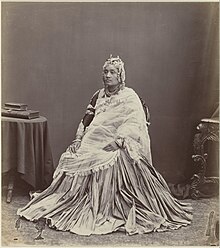Hiranya Garbha Kumari Devi (Nepali: हिरण्यगर्भ कुमारी देवी, born as Hiranya Garbha Chautari Bikram Shah,[1] also known as Maiya Maharani (Nepali: मैया महारानी);[2] 16 April 1826 – 25 February 1877) was a Nepalese maharani and principal wife of Jung Bahadur Rana.
| Hiranya Garbha Devi | |
|---|---|
| Sri Sri Sri Bada Maharani | |
 Hiranya Garbha Devi in c. 1860–75 | |
| Born | Hiranya Garbha Chautari Bikram Shah 16 April 1826 Nepal |
| Died | 25 February 1877 (aged 50) Kingdom of Nepal |
| Spouse | Jung Bahadur Rana (m. 1854) |
| Issue | Lalit Rajeshwori Rajya Lakshmi Devi |
| Dynasty | Rana dynasty |
| Father | Prana Shah |
| Mother | Moha Kumari Devi |
| Religion | Hinduism |
According to her Janam kundali, Hiranya Garbha Devi was born on 16 April 1826.[3] Her father Prana Shah was a Chautariya (equivalent to prime minister) and she was the only one daughter of Shah.[4] Her brother Fateh Jung Shah was also a prime minister of Nepal and he was killed in 1846 by Jung Bahadur Rana during the Kot massacre.[5][6]
Devi married Jung Bahadur Rana, the first Prime Minister of Nepal from the Rana dynasty, on 8 May 1854.[7][8] Upon her marriage, she was made Bada Maharani (lit. Senior Maharani).[9] Her daughter Lalit Rajeshwori Rajya Lakshmi Devi was married to Trailokya, Crown Prince of Nepal who gave birth to King Prithvi Bir Bikram Shah.[5] On 25 February 1877, Devi committed sati.[10]
Devi was described to be a "strong willed girl" as she married Rana who had killed her brother.[11] She played an important role in Jung Bahadur's life.[12]
References
edit- ^ Śreshṭha, Vishṇuprasāda (2006). Nepālako Śāha tathā Rāṇā vaṃśāvalī (in Nepali). Deba Badana Śreshṭha. p. 33.
- ^ Kumar Bhattarai, Madan (12 December 2020). "Unravelling the life of a forgotten Rana General". The Kathmandu Post. Archived from the original on 11 November 2021. Retrieved 11 November 2021.
- ^ "कुण्डलीसङग्रह" (PDF). Poornima. p. 14. Retrieved 11 November 2021.
- ^ Duḥkhī, Sundaraprasāda Śāha (1983). Prativāda: itihāsa sambaddha upanyāsa (in Nepali). Sukasaṅka Prakāśana. p. 9.
- ^ a b Raj, Prakash A. (1994). Portraits and Photographs from Nepal. Nabeen Publications. p. 7. ISBN 978-0-7855-2760-2.
- ^ Whelpton, John (1991). Kings, Soldiers, and Priests: Nepalese Politics and the Rise of Jang Bahadur Rana, 1830-1857. Manohar Publications. p. 190. ISBN 978-81-85425-64-1.
- ^ Regmi, Mahesh Chandra (1963). Land Tenure and Taxation in Nepal: Religious and charitable land endowments: Guthi tenure. Institute of International Studies, University of California. p. 192.
- ^ Shaha, Rishikesh (2001). An Introduction to Nepal. Ratna Pustak Bhandar. p. 87.
- ^ Shaha, Rishikesh (1990). Modern Nepal: 1769–1885. Riverdale Company. p. 283. ISBN 978-0-913215-64-7.
- ^ Raj, Prakash A. (1997). Queens of the Shah Dynasty in Nepal. Ratna Pustak Bhandar. p. 10. ISBN 978-0-7855-7483-5.
- ^ Rana, Pramode Shamshere J. B. (1999). A Chronicle of Rana Rule. R. Rana. p. 32.
- ^ Rana, Sagar S. J. B. (2017). Singha Durbar: Rise and Fall of the Rana Regime of Nepal. Rupa Publications India. ISBN 978-81-291-4561-1.
Further reading
edit- Rana, Greta (18 October 2012). Hidden Women: The Ruling Women of the Rana Dynasty. Roli Books Private Limited. ISBN 978-93-5194-046-3.